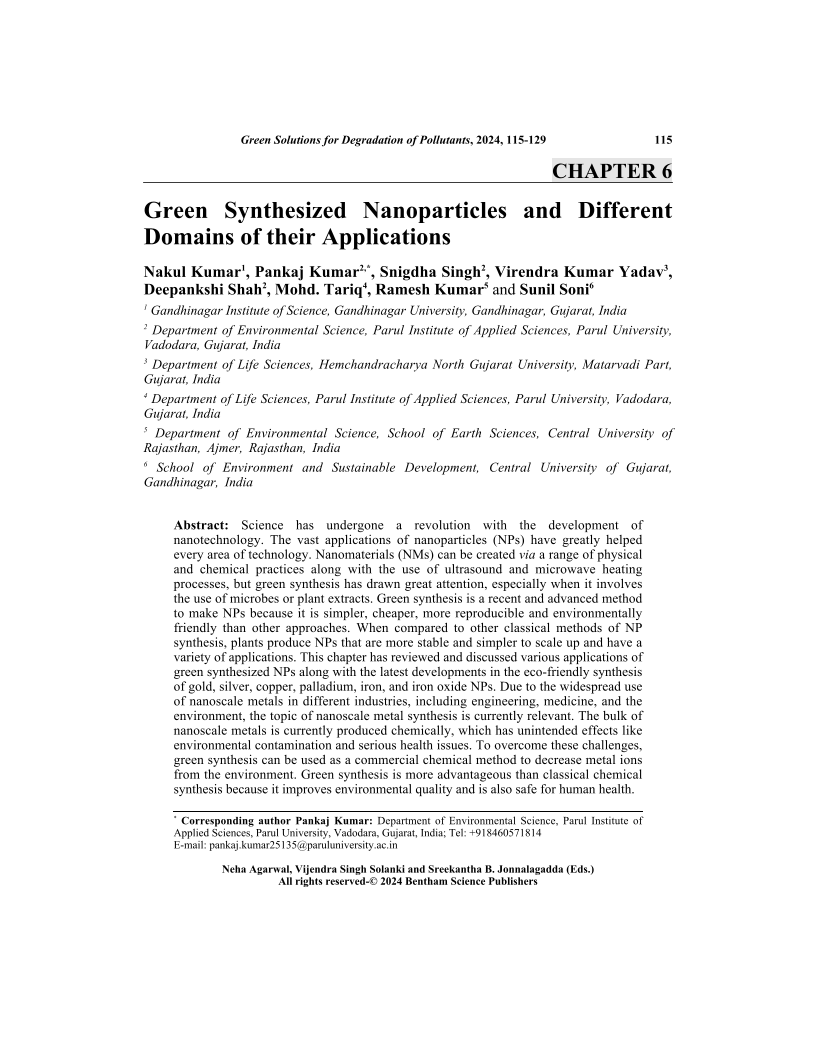Green Synthesized Nanoparticles and Different Domains of their Applications

- Authors: Nakul Kumar1, Pankaj Kumar2, Snigdha Singh3, Virendra Kumar Yadav4, Deepankshi Shah5, Mohd. Tariq6, Ramesh Kumar7, Sunil Soni8
-
View Affiliations Hide AffiliationsAffiliations: 1 Gandhinagar Institute of Science, Gandhinagar University, Gandhinagar, Gujarat, India 2 Department of Environmental Science, Parul Institute of Applied Sciences, Parul University, Vadodara, Gujarat, India 3 Department of Environmental Science, Parul Institute of Applied Sciences, Parul University, Vadodara, Gujarat, India 4 Department of Life Sciences, Hemchandracharya North Gujarat University, Matarvadi Part, Gujarat, India 5 Department of Environmental Science, Parul Institute of Applied Sciences, Parul University, Vadodara, Gujarat, India 6 Department of Life Sciences, Parul Institute of Applied Sciences, Parul University, Vadodara, Gujarat, India 7 Department of Environmental Science, School of Earth Sciences, Central University of Rajasthan, Ajmer, Rajasthan, India 8 School of Environment and Sustainable Development, Central University of Gujarat, Gandhinagar, India
- Source: Green Solutions for Degradation of Pollutants , pp 115-129
- Publication Date: August 2024
- Language: English
Green Synthesized Nanoparticles and Different Domains of their Applications, Page 1 of 1
< Previous page | Next page > /docserver/preview/fulltext/9789815238969/chapter-6-1.gif
Science has undergone a revolution with the development of nanotechnology. The vast applications of nanoparticles (NPs) have greatly helped every area of technology. Nanomaterials (NMs) can be created via a range of physical and chemical practices along with the use of ultrasound and microwave heating processes, but green synthesis has drawn great attention, especially when it involves the use of microbes or plant extracts. Green synthesis is a recent and advanced method to make NPs because it is simpler, cheaper, more reproducible and environmentally friendly than other approaches. When compared to other classical methods of NP synthesis, plants produce NPs that are more stable and simpler to scale up and have a variety of applications. This chapter has reviewed and discussed various applications of green synthesized NPs along with the latest developments in the eco-friendly synthesis of gold, silver, copper, palladium, iron, and iron oxide NPs. Due to the widespread use of nanoscale metals in different industries, including engineering, medicine, and the environment, the topic of nanoscale metal synthesis is currently relevant. The bulk of nanoscale metals is currently produced chemically, which has unintended effects like environmental contamination and serious health issues. To overcome these challenges, green synthesis can be used as a commercial chemical method to decrease metal ions from the environment. Green synthesis is more advantageous than classical chemical synthesis because it improves environmental quality and is also safe for human health.
-
From This Site
/content/books/9789815238969.chapter-6dcterms_subject,pub_keyword-contentType:Journal105

